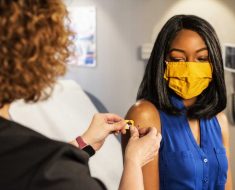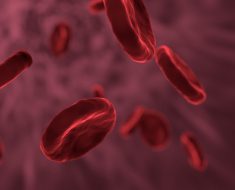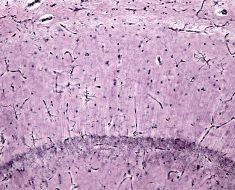Medical students aren’t the only learners in Mary Politi’s class on how health information is conveyed and received. Sometimes other faculty members attend also, to improve how they consider treatment options and discuss them with patients.
Politi, whether in person or through evidence-based decision tools she develops with others at Washington University School of Medicine in St. Louis, works with patients to empower them and help optimize their care.
“If we can better match the care patients want and need to the care they get, we can improve their patient experience and overall health,” said Politi, an associate professor of surgery and a health psychologist in the school’s Division of Public Health Sciences.
A New Jersey native, Politi earned a bachelor’s degree in psychology from Barnard College at Columbia University in 2001 and a doctoral degree in clinical psychology, with a health psychology concentration, from George Washington University in 2006. She completed her clinical internship and postdoctoral fellowship in behavioral medicine at Brown University before joining the Washington University faculty.
Timothy J. Eberlein, MD, the Bixby Professor of Surgery and head of the Department of Surgery at the School of Medicine, said Politi is “a superb researcher” and an important mentor and role model to junior faculty members and trainees in the department and at Siteman Cancer Center, where she is a researcher.
“She has spent enormous amounts of time helping others while maintaining her own incredible productivity,” said Eberlein, who also is director of Siteman. “She is an incredible human being. Not only is she a fabulous researcher, she is without a doubt one of the nicest people at WashU.”
In addition to researching and teaching about health-care communications and shared decision-making, Politi also has helped develop digital tools to help:
- People choose health insurance plans that best meet their health and financial needs.
- Breast cancer patients choose whether or when reconstruction is right for them after a mastectomy.
- Patients with Hepatitis C and advanced kidney disease decide which treatment option is best.
- Support rural cancer patients’ participation in clinical trials.
“Together, we look at ways to support decisions to positively affect their health,” Politi said. “If you really start asking people questions about what it is they value and what their daily life is like, you learn a lot about how their health fits into that picture.”
Politi discussed her field, what drew her to it, and what it can do to advance public health.
What is health psychology?
It looks at the interaction between health and behavior, and physical and mental health. From a clinical perspective, we focus on behavioral approaches to improve the health and well-being of patients. Examples are: smoking cessation, weight management, sleep management, coping with chronic illness and pain management. Broader than that, health psychology can involve trying to understand the mechanisms behind the way people make decisions or change behaviors that involve their health.
What drew you to the field?
I was always interested in how one’s environment and behaviors can impact health. My dad grew up in New York City, where he and his father were exposed to many health risks. My grandfather worked in a textile factory, where risks were often known but not discussed among workers. Living in New York City during college led me to see firsthand that some of the public health advice we gave to people failed to take into account their context, history and lifestyle.
As an undergraduate, I researched the asthma population in East Harlem, where there’s a large percentage of people with asthma and a large volume of related visits to hospital emergency rooms. We could tell someone living with asthma to minimize triggers, but if her apartment building did not have an elevator, she lived on the ninth floor and she couldn’t control the mold growing in the drywall, she couldn’t really do much about those triggers. A lot of it is environmental, but there are some behavioral strategies that can improve life for affected families and children. Engaging patients and the public and being sensitive to their needs can help us deliver more effective health interventions.
Did you have a mentor or role model along the way?
I’ve had many mentors. My first and probably most influential mentor was Dr. Catherine Monk. I worked as an undergraduate research assistant in her lab at New York-Presbyterian Hospital/Columbia University Medical Center. Dr. Monk studied behavioral medicine in maternal/fetal health, examining psychosocial influences on fetal and infant health. She was a wonderful, organized, supportive and sharp thinker who encouraged my interest in behavioral medicine and public health. She gave me hands-on experience with research, outreach and patient engagement. Her advice about pursuing a PhD in clinical health psychology helped me merge my interests in patient care and public health research. My PhD mentor, Dr. Karen Weihs, a psychiatrist who studied cancer survivorship, was also highly supportive and encouraging. We would often have dissertation meetings over a cup of afternoon tea brewed in her office teapot. As busy as she was, she never made our meetings feel rushed or unimportant, and she really took an interest in my professional growth. Both were extremely accomplished female role models, which was important for me to see as I launched my career.
Is it difficult to interest people in preventive behavioral strategies?
I don’t think it’s hard to see the value in it. The challenge is in prioritizing your time and efforts, because behavioral health isn’t something you see immediate benefits from. You do surgery, you have a good outcome, and people do well. With behavioral interventions, changes are incremental, and one intervention won’t move the needle in a huge way. But over time, the collaboration and the patient-centeredness of your care delivery, treating the patient holistically, can better improve their function, quality of life and a lot of outcomes down the line.
Describe the “big buckets” of your research.
The overarching areas are shared decision-making and health communications: how to help patients navigate uncertainty when they have more than one reasonable treatment option and how to help them become partners in their health care. That cuts across a lot of different disciplines. I focus a lot on cancer decisions because cancer helped pioneer this movement toward patient choice and autonomy. The disease can be stressful and difficult for patients to wrap their heads around. For example, a breast cancer patient may be faced with whether she should undergo reconstruction after mastectomy and, if so, when; and an early-stage lung cancer patient may have to decide between surgery or radiation therapy. Treating cancer and other diseases involves a tradeoff between risks and benefits. That’s true of many aspects of health care. I also have a grant to help people figure out which health insurance plan works best for them, given their ages, gender and health conditions. Getting people to see a health-care provider and also helping patients once they’re there are part of my research.
Of all of your research, which findings stand out for you?
One of the more exciting findings involves incorporating risk prediction into patient-facing decision tools. One example is a tool we’re working on with Dr. Terry Myckatyn, a reconstructive breast surgeon. We know that patients who undergo breast reconstruction immediately after a mastectomy might experience a complication, and there are different risks associated with different types of reconstruction. Patients’ risk factors can tell us whether they’re more or less likely to experience these complications. Breast reconstruction is complex, and it involves having one surgery right after another. For some patients, if they were to wait until their mastectomies heal before finishing cancer treatment, they might have lower rates of complication. Dr. Margie Olsen, who is in our infectious diseases group and has a joint appointment in surgery, has developed a way to predict which patients might fare better or worse. We’ve taken that information and programmed it into a patient-facing tool to help them weigh their breast reconstruction options and be better prepared for what to expect. The tool helps patients weigh the pros and cons of reconstruction so they can decide whether they want breast reconstruction surgery, when they might want it and what type to consider based on what’s important to them and their potential risks.
In general, how much do people factor in their short- or long-term health when it comes to making decisions that affect health?
Most people want to stay healthy, but I don’t know that it’s always on our minds. There’s a lot to think about getting through each day. I can tell you what’s on my mind most days: my work, my kids’ schedules, walking the dog, who’s doing school pickup at what time. I don’t know that I’m thinking at any given moment, ‘Should I be standing at my standing desk or sitting here for my health?’ But I think overall most people want to improve their health and stay healthy because it feels better.
So, it’s about helping us to accomplish that as individuals, helping to improve processes and systems to make it easier for more people to do that?
Yes, and to weigh the choices that we have at any given time. I think often when we go to the doctor we want the perfect answer with no side effects. That doesn’t exist, so it’s about helping people have better expectations about what health care can achieve and helping them think about what it is they want, given the choices they have.
This seems to be in line with our increasing focus on precision medicine.
Precision medicine is all about personalizing care to the patient in the room, and shared decision-making is really a way of communicating about that information in a way that makes sense to the patient and allows him or her to collaborate in the process. Precision medicine is a growing research area. There’s a big emphasis on genomics and informatics. There are all these interpersonal factors that come into play. Do I want to get sequencing? Does my family want me to get sequencing since it may have familial implications? How does this guide my treatment? And what’s the level of certainty and of risk that we know from this information? Because a lot of it is not deterministic; it’s all risk-based and probabilistic information, which is hard for people to wrap their heads around. We like to think in terms of, ‘This will happen or this won’t happen.’ But it is a probability. We know you’re at a higher risk for this outcome, or we have different targeted therapies available because of genetics.
When it comes to your research, what do you geek out about the most?
From a clinical perspective, when patients say they had a better experience and learned a lot from a tool we developed and that it changed their lives or the way they thought about their options, that’s the most meaningful to me.
From a research perspective, it’s when I learn something new about the way we think about problems and what’s driving a decision. For example, a patient might say, ‘I thought when you said the word ‘deductible’ it meant when you deduct down the bill to pay a lower price.’ Those are ‘a-ha’ moments for me, when I realize even common words we use in health care are not always clear to patients.
As important as these topics are, they can’t consume all of your time. What else captures your attention?
I love to be outdoors, hiking in particular. I like to take our kids, Daphne, 6, and Eliza, 3, to new areas they haven’t explored. In my past life, I fostered dogs and volunteered at animal shelters, so in September we got a rescue dog that’s about 18 months old. She’s time-consuming but really sweet and fun. My husband, Philip Skemer, is a geologist, so we named the dog Petra, which means ‘rock.’ I like to read novels after the kids go to sleep and I have the time, and I’m addicted to The New York Times crossword puzzles. Our girls take up most of my free time, though. I volunteer sometimes at their school. But mostly on the weekends, if there’s nice weather, we like to be outdoors.
Is there a common thread through your professional and personal interests?
Mindfulness and trying to be present in any given moment, whether with my family or patients.

Source: Read Full Article





